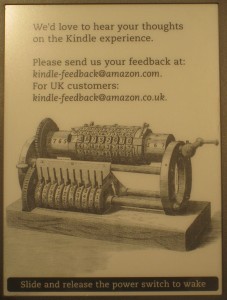The S in the INVEST mnemonic is a reminder to make your user-stories small. The trick is in knowing how small is small enough. The rule here is to make the story as small as possible, yet that it retains some measurable amount of intrinsic value — something that, when demonstrated to the end users, they’ll agree is an improvement to the system. Conversely, Continue reading User-Story Sizing: How Small is Small Enough?
Tag Archives: INVEST
Some User-Story Examples
 I’m often asked if I have any good user-story examples to share. Until recently, I always had to answer, “No,” because I didn’t have permission from my clients to share their work product. Then, the other day, it occurred to me that I could kill two birds with one stone. As an avid user of Amazon’s Kindle e-reader, I had some feedback to share with Amazon — feedback that I hope might improve the already excellent product. I decided to write up my feedback in the form of user-stories, complete with acceptance criteria. Below, therefore, you will find four new-feature stories and one bug-report story, each with three or four acceptance-test scenarios.
I’m often asked if I have any good user-story examples to share. Until recently, I always had to answer, “No,” because I didn’t have permission from my clients to share their work product. Then, the other day, it occurred to me that I could kill two birds with one stone. As an avid user of Amazon’s Kindle e-reader, I had some feedback to share with Amazon — feedback that I hope might improve the already excellent product. I decided to write up my feedback in the form of user-stories, complete with acceptance criteria. Below, therefore, you will find four new-feature stories and one bug-report story, each with three or four acceptance-test scenarios.
I did this partially just as a mental exercise, but I also reasoned that Continue reading Some User-Story Examples
User Stories: It’s SMART to INVEST
The basic framework for a good user story has 3 parts: identifying which user/role (or other stakeholder) benefits, what that person wants (the goal), and the payoff (why it’s important). You’ll often see this framework expressed as the following template: “As a ________, I want ______, so that __________”. To paraphrase Mary Poppendieck’s quintessential requirements example,
“As the VP of Distribution, I need us to redesign the REAR windshields of our cars to withstand wind-speeds of up to 130 MPH (as our FRONT windshields already do), so that we don’t have any more accidents when our cars are loaded onto transports facing backwards and then hauled at 70 MPH into a hailstorm with headwind gusts of 50 MPH.“
Since the second blank represents a goal, a lot of user-story writers find the SMART mnemonic helpful. It’s one that’s taught in traditional goal-setting seminars, but as you can see, there’s no consensus on exactly what the mnemonic stands for:
Specific / Significant / Stretching Measurable / Meaningful Attainable / Achievable Realistic / Relevant / Reasonable Time-bound / Testable / Trackable
So, a better mnemonic that’s especially pertinent to user-stories is INVEST (think “Return-on-INVESTment”): Continue reading User Stories: It’s SMART to INVEST